Screen Time (8)
By:
December 5, 2015
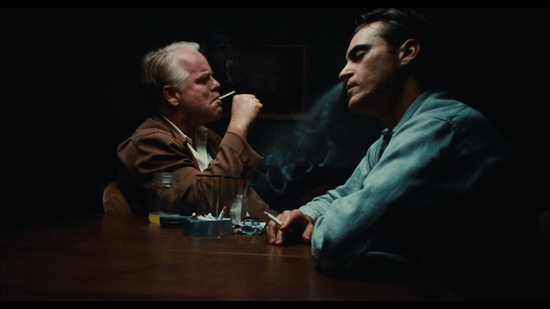
One in a series of 10 posts reprinting Jacob Mikanowski’s film and television writing from Bright Lights Film Journal and elsewhere.
The Master, dir. P.T. Anderson (2012). This essay originally appeared in The Los Angeles Review of Books.
The first time we see Freddie Quell, the dipsomaniac drifter sex-fiend cult-devotee hero of Paul Thomas Anderson’s new film The Master, he’s peering out over the prow of a ship. All we see of him are his eyes and forehead, shadowed by the brim of a combat helmet. It’s just a flash. We don’t know what he’s looking at or what he’s about to face, whether he’s about to land on an enemy shoreline or go off on leave, just that its wartime in the Pacific. But whatever happens to Freddie in the war certainly leaves a mark. The next time we see him he’s on a beach and clearly strung out, chopping coconuts with a machete like he has a mind to lop off his own hand. He celebrates V-J day by drinking ethanol out of torpedo engines. While the other sailors wrestle, Freddie simulates sex with a woman sculpted out of sand and masturbates into the surf. Back home, he flunks out of an early version of PTSD screening by claiming every Rorschach blot he’s shown is either a cock or a pussy or a cock going into a pussy. At this point we start to wonder, why are we following this creep around? Wasn’t this supposed to be a movie about Scientology?
The Master is P.T. Anderson’s sixth film. Over the past sixteen years, he’s put together a body of work that has made him stand out as one of a handful of bona fide American auteurs — directors with a discernible vision, a recognizable visual style and a commitment to the medium as an art form. Beginning with Hard Eight in 1996, he’s made a suite of films in an array of genres and moods: a perfectly executed noir short story; a sprawling Altmanesque group portrait; a haphazard (and to my mind, somewhat curdled) paean to chance; a slim, darkly funny novella; and a return-to-DeMille-and-Griffith fire and brimstone epic. All of them are held together by a fascination with a place (Southern California) and certain types of character (obsessed loners, orphaned children, surrogate fathers). Of all of these, The Master is his strangest and most elusive work. Hard Eight and Punch Drunk Love were genre pieces, however off-kilter. Boogie Nights is an exquisite ensemble piece, but it’s hardly mysterious. Magnolia and There Will Be Blood were driven by clear, if sometimes overly schematic clashes. The Master is harder to characterize. It’s a play on film history, an unresolved love story, a statement about conformity and rebellion. Above all it’s a struggle between two characters and two epochs, a duet in which nothing resolves or comes to a conclusion. It’s as wide-open, complex masterpiece, and as ambiguous and puzzling film as has appeared in America since David Lynch’s Mulholland Drive or Todd Haynes’ Safe.
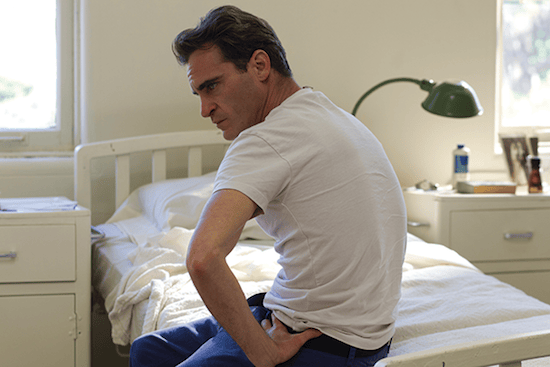
The immediate impact of The Master is of the overwhelming proximity of a single troubled mind. Freddie is what sticks with you as you leave the theater. He’s like Robert De Niro’s characters in Mean Streets and Raging Bull — as long as he’s on screen you can’t relax because something might happen to him, or he might do something terrible to someone else. You feel like you’ve gotten too close to his mania and his tics and you want to push him out. If you’ve ever been crazy, or known someone who is, you also recognize the terrible energy, like black electricity, which threatens to consume him and which he works so hard to deaden and contain. But even though he’s the most surprising and indelible thing about the film, the question remains, what is he doing here?
The answer has something to do with Freddie’s deep unease, the way he seems at odds and out of joint with his surroundings and his times. With his painfully hunched shoulders and battered, deeply-lined face he looks like an evolutionary throwback, an australopithecine John Garfield dropped off on the savannahs of a new continent. As played by Joaquin Phoenix, Freddie has the demeanor of a wounded animal. Tight spaces make him uncomfortable. Time and again, Anderson frames him in enclosures — a chicken wire shack, a ship’s hold — which make him visibly unhinged. Prison makes Freddie completely manic. When he speaks he keeps his lips pressed together, talking out of the corner of his mouth like a stroke victim. The damage extends to what he says. He’s barely able to access a memory or articulate a thought. Freddie is a creature of appetite, with a constant need for sex and drink. He doesn’t have much success with women. He’s a wizard with booze though, a moonshine alchemist who can synthesize rotgut out of whatever happens to be at hand, whether its paint thinner or Lysol. It’s this talent that ultimately wins him a place in a provisional community aboard the Master’s yacht.
Early in the movie there’s a brilliant interlude when he’s working as a department store photographer. His suit looks like it is going to strangle him. His job is to take stiff, formal portraits of ordinary American families. They’re the visual equivalent of the new Levittowns springing up all over the country. In a beautiful, fluid sequence, scored to Ella Fitzgerald’s version of “Get Thee Behind Me Satan,” he seduces (or is he seduced by?) an in-store model, but he passes out when they go out to dinner. The following day, he assaults a fat businessman who comes to have his picture taken. Next he turns up in a California cabbage field, a migrant farm worker. Before long, he accidentally poisons the patriarch of a laborer family and has to take off, running through the plowed fields pursued by a vengeful mob. On the run, he wanders out to the North Bay docks. An exquisite gliding shot captures him shambling in the foreground while a group of well-dressed revelers dance on the deck in the background. Freddie stows away, passes out, and has his flask stolen. The next morning his involvement with the Cause begins.

From this moment, The Master becomes the story of the relationship between these two vastly different men. It’s a story of initiation and servitude, and it’s a strange kind of love story, a wary dance between two figures who clearly stand for more than themselves. Lancaster Dodd, the self-styled master of the title, is a pompous little charmer in charge of his own religion, called, prosaically enough, The Cause. It’s a small-time cult with big-money donors, which promises its adherents a cure for all mental handicaps and certain forms of leukemia, as well as an end to nuclear war. Dodd has an enormous sense of his own importance. In his own words, he’s “a writer, a doctor, a nuclear physicist, a theoretical philosopher… but above all I am a man.” He’s a genial charlatan and a barely restrained bully, but he’s also an immensely charismatic, frivolous, joyful presence. Dodd is a drinker and a gadabout, a blowhard and a fraud, a giddy charlatan and a theater ham. More than once, he leads his disciples in a satyr dance, and he draws Freddie to him with a giddy wedding toast about taming dragons until they roll over.
If Phoenix’s Freddie descends from the early performances of De Niro and Brando, Philip Seymour Hoffman’s Dodd is Orson Welles, especially the self-consciously theatrical show-off of the later years, the man behind the curtain from Mr. Arkadin and the bogus magician of F is for Fake. You get the sense that if he didn’t hold the keys to the last 60 trillion years of human spiritual existence, Dodd would have been a brilliant magician, as Welles was during the war years, when he was staging magic shows for the troops with Marlene Dietrich for an assistant, sawing Rita Hayworth in half every night while dreaming of running for president. And remember that, with the radio broadcast The War of the Worlds, Welles created, however briefly, his own moment of extraterrestrial awe and terror. But Anderson doesn’t just call up Welles the magician; The Master also draws on the noir Welles, the Welles of impossible and dangerous desires. Sly references to Lady From Shanghai tumble through the film. There’s the initial stowaway sequence and the voyage on the Alethea from San Francisco to New York, the exact reverse of the course taken by Welles’ Michael O’Hara in Lady. Then there’s the back story with Freddie’s would-be child-bride, whom he leaves to be an oiler on a merchant marine cruise to Shanghai. And finally, there’s the song. In their final meeting, just as he is about to banish Freddie for good, Dodd sings him, “I’d like to get you on a Slow Boat to China,” to Freddie in a low, steady voice, as if it was a lullaby or a plea. It’s a shocking moment, at once comic, absurd and tragically sexy — one of the sexiest things I’ve seen on screen in years. For these two, Shanghai is a ways off from Welles’ “wickedest city in the world.” It’s their territory ahead, the dream space of their imaginary, infinitely displaced ground of their union.
Of course, on a more direct level, Dodd’s character and appearance are clearly modeled on L. Ron Hubbard, down to the self-description as a theoretical physicist. His movement, The Cause, strongly resembles the early version of Scientology, the one that became an overnight sensation thanks to the success of Dianetics. With some scrambling and compression of chronology, many of the events of Hubbard’s life are in The Master as well — the sojourn on the boat, the refuge with wealthy patrons, the embezzlement, the party congress in Phoenix, the retreat to England — are all based on fact, with the exception that the real story of Hubbard’s rise was much weirder and more sordid, featuring multiple divorces, a kidnapping, fraud charges, conspiracy theories and a cabal of well-heeled Southern California necromancers.
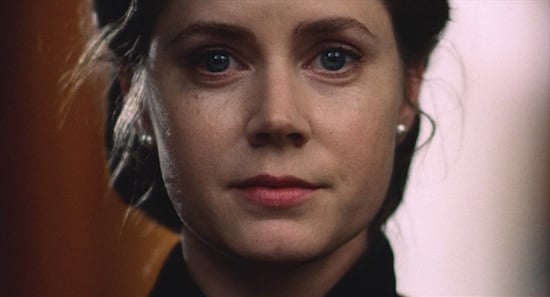
So what draws Dodd to Freddie and Freddie to Dodd? They have a strange sort of partnership. Dodd has his processing techniques and Freddie has his secret varnish-cocktail recipe. Literally and figuratively, they spend the movie drinking each other’s moonshine. More than that, an obvious erotic current runs between the two, especially from Dodd to Freddie. They wrestle and lock eyes. In his own life, Dodd is clearly under the thumb (and sexually, the hand) of his wife Peggy, played the superb, but underused Amy Adams, a fanatical believer in the movement and a jealous guardian of her husband’s prestige. Maybe as recompense, Dodd enjoys having someone to dominate on his own. At times Freddie’s his disciple, at others, something closer to a slave. He’s also a science project, a lump of proletarian clay on which to test Dodd’s theories. For much of the middle portion of the film, Dodd treats Freddie like a savage pet, and seems to relish having such an animal at his command. He’s the violent id to his silken superego. He calls him “naughty boy” and “dog,” but at the same time, clearly relishes the violence Freddie is willing to do in his name.
But the attraction between Freddie and Dodd has less to do with violence and control than with therapy, and with secrets. In return for his devotion, Dodd is able to give Freddie some kind of relief, which isn’t that far from pain. The army’s psychotherapy bounces off Freddie completely, but Dodd manages to open him up. In the movie’s most powerful scene, Dodd casually offers him a session of “informal processing” below decks. He forces Freddie to keep his eyes open without blinking, while answering a series of questions that go to the root of his shame and fear, his history of incest, alcoholism, family insanity. As he answers, the veins pop out of his face, a scene accompanied by extreme, almost sexual exertion. His past flows out of him, like a boil that’s been lanced. It’s a scene of incredible power, like watching a real-life exorcism or someone speaking in tongues. But however effective this treatment is in the short term, its effects don’t last, and at a deeper level Freddie never really succumbs to the appeal of the Cause.
It’s a bold choice on Anderson’s part to portray the Cause as sympathetically as he does. Dodd’s technique is a mix of past-life regression and behavioral modification. It offers its adherents a chance to recall their time in the womb and to dream of past lives. Part of the Master’s mystique is his perfect recollection of his previous incarnation, and his ability to induce a similar recall in others. For older rich women (like Helen Sullivan, played by Laura Dern), this has the appeal of playacting, travelling into other selves, pretending to be a knight or a slave. But the Cause isn’t only about play. It’s also meant to domesticate darker impulses. Like Scientology, it sort of combination of the other two great American-born religions — Mormonism and Alcoholics Anonymous. Like Mormonism, it is rooted in an ancient mystery and the promise of revealed truth. (Dodd keeps his scriptures buried in the desert — there’s a wonderful scene where he takes Freddie with him to dig them up and once they’re in hand pauses for a moment with gun in hand, as if they might be ambushed by enlightenment-seeking desperadoes). Like Alcoholics Anonymous, it is a form of therapy and spiritual discipline (or at least, discipline). Like both, it offers a path toward getting well and fitting in. (That’s American religion. Cults are another matter, since everywhere they tend to be about sexual control, an insight which seems to be conveyed in a vision of Dodd’s party in which all the women are nude.)
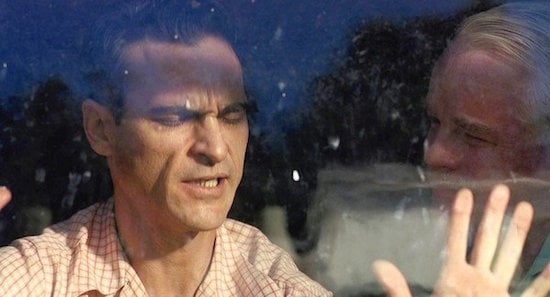
Part of this works on Freddie. When Dodd screens him, the effect is like a thunderbolt. But the rest of it fails. Freddie never grasps the intricacies of the doctrine and never joins the others in fantasies of past lives. There’s an anguished scene in which he walks from wall to window, over and over again for what feels like an eternity, while being prodded to imagine them as portals to somewhere else. As with the Rorschach test and the sand woman, he reveals the scope and limits of his imagination — mimicking sex with the window instead of playing Dodd’s game. The scene of training that comes close to being torture. It put me in mind of a scene from François Truffaut’s neglected The Wild Child, in which a feral boy is trained by an enlightened doctor, in tiny increments, to speak and understand symbols. Freddie’s resistance goes beyond merely not believing. He seems resists the very idea of abstract thought.
The rest of the program has to do with learning to control impulsive behavior, disciplining the mind, acquiring the ability to speak clearly and forcefully and to withstand scrutiny. And in this, Freddy fails completely. Drawn into the center of the Cause’s impromptu family, he remains an unbridled force. When Dodd and Quell are arrested (Dodd for embezzlement, Quell for attacking the police officers who came to arrest him) they are held in separate cells, side by side. Freddie goes on a self-destructive rampage, slamming his head into the bunks and stomping a toilet into pieces. Meanwhile, Dodd coolly stands in the corner, insisting “I’m the only one who likes you.” Freddie, desperate, screams “It’s all bullshit… you’re making it all up… say one thing that’s true” in reply. Framed this way, side-by-side in their separate cells, the contrast between the two men is at its starkest. But its meaning remains ambiguous. It can be read in a couple of ways, as the opposition between spirit and nature, man and animal, or even (as several critics have suggested) between styles of acting, with Freddy as an exemplar of the method school and Dodd squarely in the older theatrical tradition.
Another way to think about the contrast between the two is in terms of historical eras and genres. There’s something about Freddie that keeps him from fitting in to the postwar world. When he arrives back from the war, Freddie outwardly resembles many of the noir figures that populated postwar films: Frank Chambers, the drifter who rolls of a hay truck into Lana Turner’s lap at the start of The Postman Only Rings Twice; Orson Welles as Michael O’Hara, climbing on board a rich man’s yacht in The Lady From Shanghai; Tom Neal, the gutter musician antihero of pulpier-than-thou Detour. Like them, Freddie is disconnected in the new America, at loose, looking for trouble. But he lives in a different moral universe from these men. He doesn’t have any of the noir heroes’ sardonic self-regard or their fatalism. In the great postwar noirs, the hero chooses his fate. O’Hara’s motto is “When I start out to make a fool of myself, there’s very little can stop me.” Freddie is a creature of instinct, a Pavlovian mass a skittering neural tissue, incapable of either Welles’ wryness or Robert Mitchum’s inner distance. Puss crazy as he is, amour fou isn’t exactly on his horizon either, and until the end it’s an open question whether he’s capable of consummating a relationship at all.
(That final scene of Freddie having sex is fascinating in its own right. In the middle of it, Freddie pauses to ask his lover the questions from Dodd’s processing session. It’s as if he’s flipping the script and finally getting the upper hand on his master, while consummating the relationship at the same time. According to IMDB, the girl he picks up is named Wynn Manchester — in the theater, I could have sworn her name was Lancaster).
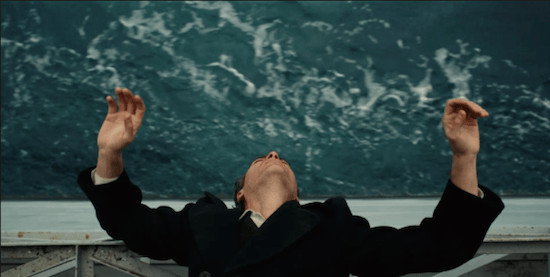
Really, the more you look at him, the more Freddie seems to belong to an earlier era, to the pre-war world of hoovervilles, tramp cottages, migrant workers. When he’s working on the cabbage plantation by Salinas, he’s right in the heart Steinbeck country. He meets a man there who reminds him of his father, a gnarled farm worker with a long beard, who looks like he stepped out of a Dorothea Lange photograph. When he’s on the run from migrant camp, he could be an escapee from a chain gang in Sullivan’s Travels. This is a half-wild America, still wide open, the country as it was before the rise of subdivisions and psychometrics. At the same time, Freddie is a portrait of the men of Anderson’s father’s generation. Anderson’s own father served in the Pacific theater, and he has said that afterwards he “was restless his whole life.” The identification between the two is strengthened when you notice that Freddie comes from Lynn, Massachusetts, Anderson’s father’s hometown.
There Will Be Blood was set during the closing of the frontier… the 1950 of The Master is a similar moment, when another kind of freedom was on its way out. Freddie is just another drifter, but he’s also stands for a whole lost continent of unchecked American freedom and wartime trauma, a country without surveillance where which you could rise from nowhere or bug out and vanish. It’s a country that in 1950 was in the process of vanishing, and Scientology, or the Cause, was helping it on its way. Dodd’s movement was the heir to two hundred years of religious revivalism and spiritual exploration, reaching back to the Shakers and Seventh Day Dunkers and forward to Esalen and the Unification Church (for a glimpse of this world, nothing can top Paul Johnson’s The Kingdom of Matthias, in which a very Hubbard-like New York carpenter suddenly leaves his trade to preach the transmigration of souls and practice free love).
But The Cause also belongs to its moment. It’s a pseudoscience tailored to address both mounting fears about atomic energy and to benefit from the rising popularity of psychoanalysis. In its theology, the Cause is a mystical system dedicated to the idea of the eternal return in which time passed in trillion year cycles. In its practice, however, it is a sophisticated technology of the self, dedicated towards fostering integration “within a group, a society, a family.” In Anderson’s world, the Cause is the future, and poor, drunk, feral Freddie is the past.
In their final meeting, Dodd asks Freddie if he has found a way to live without a master, and if he does to “be sure to let the rest of us know, for you would be the first in the history of the world.” This is Freddie’s predicament: living without any master or law means living like an animal, but succumbing totally to his hypnotism and mind tricks means giving up your soul, and as Isaiah Berlin once pointed out, submission can be its own kind of freedom, especially when the alternative is rootlessness and oblivion. But the fascination of the film is that their relationship extends beyond that of a master and a disciple or a master and a slave into something deeper, a dependence born out of an intoxication with opposing ways of living in the world.
Fundamentally, The Master is a story of love between unequals, taking place at a pivot moment when American culture and history. It’s a version of the oldest American story, the fraught love between the civilized and the savage, the story that runs back from Sal and Dean in On The Road and Queequeg and Ishmael on the Pequod, or back to Robinson Crusoe and Friday. Ultimately, it goes back to that ur-parable of American colonization, Shakespeare’s Tempest. Freddie and Dodd are like Caliban and Prospero; the animal-man and his wizard master. Could that be why Freddie, earth spirit, begins and ends the movie having sex with the sandcastle woman, and why Dodd is forever plotting against his enemies from the prow of a boat?
I don’t mean to suggest The Tempest as a skeleton key for the whole film. I think it’s present, buried deep in the background. The movie certainly helps make sense of the play. Once you see Prospero as Dodd you realize what an ass he must have been, padding around his island in his magic robe making speeches and shouting at all the natives for not loving him enough. Like The Master, The Tempest takes place after a moment of forcible colonization. It’s a story of domestication and enslavement, and of indoctrination through language. What’s not remarked on often enough is that it’s also a buried love story. Their relationship began like Dodd’s and Freddie’s: each had something to offer the other one. Prospero was a newcomer to the island once, and a hounded political refugee at that. Caliban remembers those days “When thou camest first / Thou strokedst me and madest much of me,” he reminds his master. Prospero taught him, too, “How / To name the bigger light, and how the less, / That burn by day and night.” Prospero taught Caliban language and gave him affection, while Caliban showed Prospero how to live in the wild — what to eat, what to drink. In that half-remembered past, there was an openness between them: they were still more like father and son than master and slave.
In the end though, Freddie ends up shunted aside, just as Caliban was, but with the Cause there are oceans of time in which to make up for present crimes. From the time they meet, Dodd insists that he has met Freddie in a past life. At the end he finally reveals where and when that was: they worked the pigeon post together during a siege in the Franco-Prussian War, sending dozens of balloons into the air and only losing a few. It’s a lovely, goofy dream of camaraderie. But after Freddie asks, finally and pathetically, if they can be friends in a future life, Dodd tells him that if he leaves they will be mortal enemies for the next million years. The film closes with him back on the beach, nestled against the sandcastle woman from the first scenes, but the movie’s real ending comes before, when Freddie and Dodd are racing motorcycle in the Arizona desert. Dodd tells Freddie to choose a point in the distance and race towards it as fast as he can. The disciple rushes off, slipping his bonds and vanishing in the American distance, leaving a trail of possible futures behind him like eddies in a ship’s wake.
CURATED SERIES at HILOBROW: UNBORED CANON by Josh Glenn | CARPE PHALLUM by Patrick Cates | MS. K by Heather Kasunick | HERE BE MONSTERS by Mister Reusch | DOWNTOWNE by Bradley Peterson | #FX by Michael Lewy | PINNED PANELS by Zack Smith | TANK UP by Tony Leone | OUTBOUND TO MONTEVIDEO by Mimi Lipson | TAKING LIBERTIES by Douglas Wolk | STERANKOISMS by Douglas Wolk | MARVEL vs. MUSEUM by Douglas Wolk | NEVER BEGIN TO SING by Damon Krukowski | WTC WTF by Douglas Wolk | COOLING OFF THE COMMOTION by Chenjerai Kumanyika | THAT’S GREAT MARVEL by Douglas Wolk | LAWS OF THE UNIVERSE by Chris Spurgeon | IMAGINARY FRIENDS by Alexandra Molotkow | UNFLOWN by Jacob Covey | ADEQUATED by Franklin Bruno | QUALITY JOE by Joe Alterio | CHICKEN LIT by Lisa Jane Persky | PINAKOTHEK by Luc Sante | ALL MY STARS by Joanne McNeil | BIGFOOT ISLAND by Michael Lewy | NOT OF THIS EARTH by Michael Lewy | ANIMAL MAGNETISM by Colin Dickey | KEEPERS by Steph Burt | AMERICA OBSCURA by Andrew Hultkrans | HEATHCLIFF, FOR WHY? by Brandi Brown | DAILY DRUMPF by Rick Pinchera | BEDROOM AIRPORT by “Parson Edwards” | INTO THE VOID by Charlie Jane Anders | WE REABSORB & ENLIVEN by Matthew Battles | BRAINIAC by Joshua Glenn | COMICALLY VINTAGE by Comically Vintage | BLDGBLOG by Geoff Manaugh | WINDS OF MAGIC by James Parker | MUSEUM OF FEMORIBILIA by Lynn Peril | ROBOTS + MONSTERS by Joe Alterio | MONSTOBER by Rick Pinchera | POP WITH A SHOTGUN by Devin McKinney | FEEDBACK by Joshua Glenn | 4CP FTW by John Hilgart | ANNOTATED GIF by Kerry Callen | FANCHILD by Adam McGovern | BOOKFUTURISM by James Bridle | NOMADBROW by Erik Davis | SCREEN TIME by Jacob Mikanowski | FALSE MACHINE by Patrick Stuart | 12 DAYS OF SIGNIFICANCE | 12 MORE DAYS OF SIGNIFICANCE | 12 DAYS OF SIGNIFICANCE (AGAIN) | ANOTHER 12 DAYS OF SIGNIFICANCE | UNBORED MANIFESTO by Joshua Glenn and Elizabeth Foy Larsen | H IS FOR HOBO by Joshua Glenn | 4CP FRIDAY by guest curators
